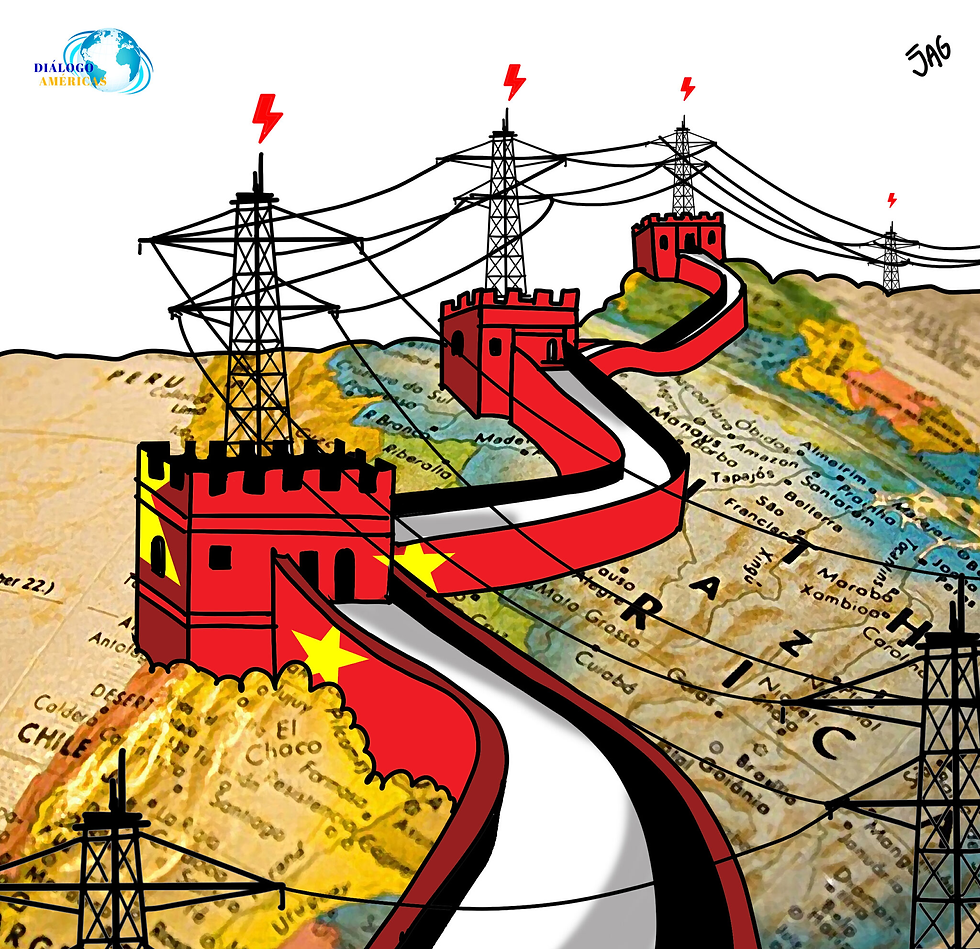The Middle-Income Trap: Stagnant Innovation and Growth in Latin America
- Dane Prins

- Feb 11, 2024
- 9 min read
Updated: Feb 25, 2024
In the international arena, nations strive to enhance their political and economic position (Felipe, Abdon & Kumar, 2012; Gill & Kharas, 2015). Achieving this objective requires not only fostering strong international relations and participating in multilateral organizations, but also ensuring internal stability and efficiency (Felipe, Abdon & Kumar, 2012; Gill & Kharas, 2015). Effective internal governance and functional structures are crucial as they underpin economic growth and societal well-being (Rothstein & Teorell, 2008; Ali, 2015).
Furthermore, the ability of a nation to continually improve its systems, prioritize investments in key sectors, and foster innovation is central to its competitiveness on the global stage (Rothstein & Teorell, 2008; Ali, 2015; Gill & Kharas, 2015). This pursuit of economic development is a relentless task, with nations aiming to ascend to the status of high-income countries (Felipe, Abdon & Kumar, 2012; Gill & Kharas, 2015). While some countries experience rapid economic growth, propelling them towards this goal, others encounter hurdles along the way (Felipe, Abdon & Kumar, 2012). For many, particularly in Latin America, the journey to sustained economic prosperity is fraught with challenges, including the notorious middle-income trap (Paus, 2014; Gill & Kharas, 2015; Larson, Loayza & Woolcock, 2016).
The middle-income trap describes a phenomenon wherein countries achieve moderate economic success, often transitioning from low to middle-income status, but struggle to make further progress (Felipe, Abdon & Kumar, 2012; Gill & Kharas, 2015). Latin America serves as a pertinent case study in understanding this concept and its implications (Paus, 2014; Gill & Kharas, 2015; Larson, Loayza & Woolcock, 2016). This article aims to delve into the intricacies of the middle-income trap, particularly as it pertains to the Latin American context. Beginning with an examination of the middle-income trap concept, this article will explore the factors contributing to stagnation and the challenges associated with breaking free from its grip. By explaining these dynamics, this article aims to provide insights into potential strategies and pathways for nations to overcome this developmental struggle and foster sustained economic growth.
Exploring the 'the Middle-Income Trap' Phenomenon Following Periods of Economic Growth
Historically, the economic development of nations has been characterized by a gradual progression, often delineated by the stages of low-income, middle-income, and high-income classifications (Felipe, Abdon & Kumar, 2012). This progression ideally unfolds with minimal disruptions or delays (Felipe, Abdon & Kumar, 2012). Initially positioned as low-income countries, these nations contend with pervasive poverty and underdevelopment vis-à-vis the global landscape (Felipe, Abdon & Kumar, 2012). The transition to middle-income status signifies a crucial phase for countries, offering them the chance to strengthen their domestic conditions (Felipe, Abdon & Kumar, 2012; Gill & Kharas, 2015). It also provides a foundation for subsequent developmental endeavors (Felipe, Abdon & Kumar, 2012).
As such, attaining high-income status is the ultimate objective for every nation (Felipe, Abdon & Kumar, 2012; Gill & Kharas, 2015; Kang & Paus; 2020). It symbolizes economic stability, global influence, and active participation in international trade and diplomacy (Felipe, Abdon & Kumar, 2012). The nexus between economic advancement and the overall development of a nation, as well as international stature, underscores the critical importance of improving the economic sector (Felipe, Abdon & Kumar, 2012). Yet, the path toward high-income status is filled with intricacies and challenges. It requires adept navigation of economic policies, technological developments, and global market dynamics (Felipe, Abdon & Kumar, 2012; Gill & Kharas, 2015; Kang & Paus; 2020).
Sometimes, the progression from low-income countries to high-income status encounters obstacles, particularly when navigating the middle-income position (Felipe, Abdon & Kumar, 2012). Transitioning from low-income to middle-income status represents a significant leap forward in the competitive global landscape, pulling countries closer to achieving high-income status (Felipe, Abdon & Kumar, 2012). However, some nations that have attained middle-income status may regress to low-income status or become stuck in the middle-income bracket for an extended period (Felipe, Abdon & Kumar, 2012; Gill & Kharas, 2015). This phenomenon, termed the "middle-income trap" by researchers Gill and Kharas (2015), occurs when a country struggles to advance beyond its current economic status and faces challenges in investing in innovation or technology (Felipe, Abdon & Kumar, 2012).
In their study of economic development in East Asia, Gill and Kharas (2015) identified a notable absence of overarching growth strategies applicable to the entire region. Policymakers encountered the dilemma of their nations being stuck in the middle-income status, unable to progress further (Gill & Kharas, 2015). This issue transcended regional boundaries and appeared to manifest in other regions such as Latin America, where formerly dynamic economies experienced abrupt stagnation (Gill & Kharas, 2015; Larson, Loayza & Woolcock, 2016). While maintaining middle-income status is preferable to regressing to low-income status, it nonetheless represents a suboptimal position (Felipe, Abdon & Kumar, 2012). Gill and Kharas (2015, p. 2) observed the phenomenon across numerous middle-income economies and subsequently introduced the concept of the "middle-income trap." They aimed to catalyze further research and develop strategies for facilitating economic advancement (Felipe, Abdon & Kumar, 2012; Gill & Kharas, 2015). To delve deeper into this subject, the following sections will examine the manifestation of the middle-income trap in Latin America, scrutinize the factors contributing to its entrenchment, and explore potential pathways for overcoming this developmental hurdle.
From Theory to Reality: Unveiling the Middle-Income Traps Presence in Latin America
The middle-income trap, a prominent concept within academic discourse, denotes the situation wherein middle-income countries become entrenched within that economic stratum (Felipe, Abdon & Kumar, 2012; Gill & Kharas, 2015). This phenomenon, extensively documented in scholarly literature, is characterized by a prolonged stagnation in economic growth and development despite initial advancements (Felipe, Abdon & Kumar, 2012; Gill & Kharas, 2015; Larson, Loayza & Woolcock, 2016). The transition beyond this stage presents formidable challenges (Gill & Kharas, 2015). The absence of overarching or universally applicable developmental strategies complicates efforts to sustain growth and propel economies to higher income levels (Felipe, Abdon & Kumar, 2012; Gill & Kharas, 2015). Consequently, numerous nations endure long periods within the middle-income bracket, grappling with the complexities of moving forward (Felipe, Abdon & Kumar, 2012; Gill & Kharas, 2015; Larson, Loayza & Woolcock, 2016). It is worth noting that this phenomenon transcends geographical boundaries, manifesting globally, thereby underscoring the shared challenges faced by middle-income economies worldwide (Gill & Kharas, 2015; Kang & Paus; 2020).
However, this article concentrates on the regional context of Latin America, where the middle-income trap has emerged as a palpable reality. Gill and Kharas (2015) underscore how several Latin American economies, notably Brazil, have been ensnared in this phenomenon. Despite experiencing exponential growth, these nations transitioned from low-income to middle-income status (Gill & Kharas, 2015). Initially, predicated on their rapid economic expansion, it was envisaged that they would ascend to high-income status (Gill & Kharas, 2015). Nonetheless, this anticipation has yet to materialize, with many countries lingering in stagnation for prolonged periods, as highlighted by Gill and Kharas (2015). This regional perspective illuminates the challenges and dynamics at play within Latin American economies grappling with the middle-income trap (Gill & Kharas, 2015).
Larson, Loayza, and Woolcock (2016), economic professionals at the World Bank, conducted a comprehensive analysis of the middle-income trap, significantly contributing to the scholarly understanding of this phenomenon. Their in-depth examination, documented in a policy report commissioned by the World Bank, sheds light on the nuanced dynamics prevalent in Latin American and Middle Eastern economies (Larson, Loayza & Woolcock, 2016). Their investigation reveals a recurring pattern whereby countries within these regions experience robust economic growth that propels them to middle-income status (Larson, Loayza & Woolcock, 2016). However, subsequent progress becomes stagnant, with nations remaining trapped in this economic phase for prolonged periods (Larson, Loayza & Woolcock, 2016). This predicament, persisting over several decades, poses substantial challenges for policymakers and economists alike (Gill & Kharas, 2015; Larson, Loayza & Woolcock, 2016).
Of particular concern is the observation that despite widespread acknowledgment of the importance of sustained economic growth (Felipe, Abdon, & Kumar, 2012; Paus, 2014; Gill & Kharas, 2015; Larson, Loayza & Woolcock, 2016), many economies tend to experience a notable plateau once they attain middle-income levels (Larson, Loayza & Woolcock, 2016; Kang & Paus; 2020). This empirical reality complicates efforts to devise effective strategies for transcending the middle-income trap (Felipe, Abdon, & Kumar, 2012; Paus, 2014; Gill & Kharas, 2015; Larson, Loayza & Woolcock, 2016). Thus, the scholarly inquiry from Larson, Loayza, and Woolcock (2016) underscores the urgency of further research and innovative policy interventions to address the complex dynamics underlying the middle-income trap. Their work not only incentivizes academic discourse but also provides invaluable insights for policymakers striving to navigate the challenges of economic development in middle-income countries (Larson, Loayza & Woolcock, 2016).
When examining the economic trajectory of Latin America, it is essential to delve into the circumstances that have shaped its current status. During the late 1990s to early 2000s, several Latin American countries confronted substantial financial crises, which prompted a need for reform amid deteriorating market conditions (Lin & Treichel, 2012; Paus, 2014). In response, the region embarked on a period of economic restructuring, characterized by the implementation of new policies and the adoption of alternative economic approaches (Lin & Treichel, 2012). These measures enabled nations within Latin America to seize opportunities presented by high commodity prices and increased capital inflows, leading to significant growth within a relatively short time frame (Lin & Treichel, 2012). This growth was accompanied by improvements in poverty reduction and income inequality, reflecting the positive impact of these economic reforms (Lin & Treichel, 2012). Bolstered by these initial successes, Latin America fostered anticipation for further development in the years to come (Lin & Treichel, 2012; Paus, 2014; Gill & Kharas, 2015; Larson, Loayza & Woolcock, 2016).
Catalyzing Prosperity: Harnessing Innovation as a Gateway to Overcoming the Middle-Income Trap
Nevertheless, it became increasingly apparent that sustained innovation was paramount for the continued economic expansion of Latin America, a sentiment echoed by scholars across various studies (Felipe, Abdon, & Kumar, 2012; Lin & Treichel, 2012; Paus, 2014; Gill & Kharas, 2015; Larson, Loayza & Woolcock, 2016). While the region initially experienced growth by capitalizing on its abundant natural resources, there was a lack of emphasis on fostering high-tech industries and expanding manufacturing exports (Lin & Treichel, 2012; Paus, 2014). This oversight resulted in Latin America falling behind in meeting international demands, rendering its growth potentially unsustainable and heightening its susceptibility to global economic downturns (Lin & Treichel, 2012; Paus, 2014).
Moreover, the shortage of innovation over time posed significant challenges for middle-income countries in Latin America (Lin & Treichel, 2012; Paus, 2014). This hindered their ability to invest in the indispensable infrastructure and capabilities needed to ascend to high-income status (Lin & Treichel, 2012; Paus, 2014). Consequently, the pace of innovation in the region slowed considerably, leading many countries to become entrenched in their middle-income status (Lin & Treichel, 2012; Paus, 2014; Gill & Kharas, 2015; Larson, Loayza & Woolcock, 2016). This stagnation underscores the urgent need for Latin American nations to refocus their efforts on fostering innovation and diversifying their economies to break free from the middle-income trap and achieve sustained economic growth (Lin & Treichel, 2012; Paus, 2014; Gill & Kharas, 2015; Larson, Loayza & Woolcock, 2016).
Furthermore, researchers and economists Lin and Treichel (2012) conducted further studies on how Latin America can overcome this challenge, drawing parallels with successful Chinese strategies. Scholars suggest that Latin America could adopt similar approaches to rise and escape from the middle-income trap (Lin & Treichel, 2012). Lin and Treichel (2012) emphasize the importance of leveraging comparative advantage to enhance market competitiveness in the region. Eva Paus (2014) contributes to the discussion by highlighting in her research that although Latin American economies saw growth during the 2000s, sustaining it demands an in-depth understanding of the imperative to strengthen productive capabilities for adaptation to globalization (Paus, 2014).
Therefore, while focusing on comparative advantage is crucial (Lin & Treichel, 2012), Paus (2014) emphasizes the importance for economies to transition from factor-driven growth to innovation-driven growth. Paus (2014) further discusses the concept of the middle-income trap, describing it as a situation where countries struggle to ascend to high-income status due to challenges in competing internationally caused by high wages and low productivity. Hence, countries must maintain growth by meeting international market demands, fostering innovation, and further developing industries (Kang & Paus, 2020; Lin & Treichel, 2012; Paus, 2014), particularly pertinent for Latin American nations aiming to break free from the middle-income trap (Kang & Paus, 2020; Lin & Treichel, 2012; Paus, 2014).
Furthermore, governments must prioritize the evaluation of the social and political capacities inherent within their industries and production systems (Paus, 2014). Although there is no universally applicable strategy to overcome the middle-income trap, governments bear the responsibility of identifying comparative advantages and fostering innovation in these areas to drive progress (Kang & Paus, 2020; Paus, 2014). Thus, the ability to circumvent this trap in Latin America hinges on adopting strategies rooted in the region's productive capabilities (Paus, 2014). Governments and industries must uphold transparency and accountability while leveraging their strengths to devise policies and strategies (Paus, 2014). Furthermore, this endeavor aligns with the necessity of systematically building productive capabilities over the long term (Kang & Paus, 2020), addressing both domestic and international challenges unique to the progression of each economy (Kang & Paus, 2020).
In conclusion, Latin American economies, alongside other middle-income economies globally, are susceptible to stagnation (Felipe, Abdon, & Kumar, 2012; Paus, 2014; Gill & Kharas, 2015; Larson, Loayza & Woolcock, 2016). Despite experiencing substantial growth, there is no assurance of attaining high-income status, particularly in the absence of conducive policies and a focus on innovation (Felipe, Abdon, & Kumar, 2012; Paus, 2014; Gill & Kharas, 2015; Larson, Loayza & Woolcock, 2016). The rapid expansion of Latin American industries in the 2000s underscored the potential for growth by leveraging comparative advantages (Lin & Treichel, 2012; Paus, 2014).
However, a meticulous approach is essential, emphasizing the significance of shifting focus toward innovative sectors within the industry (Paus, 2014; Kang & Paus, 2020). Collaboration among governments, industries, and policymakers is crucial to fostering an environment conducive to innovation and productivity enhancement (Paus, 2014). This collaborative effort will not only facilitate economic growth but also lay the groundwork for sustainable development and resilience against future challenges in Latin America and other middle-income economies worldwide (Paus, 2014).
Bibliographical References
Ali, M. (2015). Governance and Good Governance: A Conceptual Perspective. Dialogue (Pakistan), 10(1).
Felipe, J., Abdon, A., & Kumar, U. (2012). Tracking the middle-income trap: What is it, who is in it, and why?. Levy Economics Institute, Working Paper, (715).
Gill, I. S., & Kharas, H. (2015). The middle-income trap turns ten. World Bank Policy Research Working Paper, (7403).
Kang, N., & Paus, E. (2020). The political economy of the middle income trap: The challenges of advancing innovation capabilities in Latin America, Asia and beyond. The Journal of Development Studies, 56(4), 651-656.
Larson, G. M., Loayza, N., & Woolcock, M. (2016). The middle-income trap: myth or reality?. World bank research and policy briefs, (104230).
Lin, J. Y., & Treichel, V. (2012). Learning from China's rise to escape the middle-income trap: a new structural economics approach to Latin America. World Bank policy research working paper, (6165).
Paus, E. (2014). Latin America and the middle-income trap. ECLAC, Financing for Development Series, (250).
Teorell, J., & Rothstein, B. (2008). What is Quality of Government: A Theory of Impartial Institutions. GOVERNANCE: An International Journal of Policy, Administration and Institutions, 21(2), 165-190.
Visual Sources
Cover Image: Pilling, D. (2013). The benefits and perils of riding China’s coat-tails [Digital Illustration]. Retrieved from: https://www.ft.com/__origami/service/image/v2/images/raw/ftcms%3Ae5f326b2-fa0a-11e2-98e0-00144feabdc0?source=next-article&fit=scale-down&quality=highest&width=700&dpr=1
Figure 1: Swisshippo (n.d.). The dream of a single Latin American currency [Photograph]. Retrieved from: https://static.dw.com/image/62025908_1004.webp
Figure 2: FocusEconomics (2023). 2023 Latin American GDP Outlook [Photograph]. Retrieved from: https://twitter.com/FocusEconomics/status/1702364220296171783/photo/1
Figure 3: Lee, Y. (2021). Debt Relief for Middle-Income Countries: Can the International Community Meet the Moment? [Photograph]. Retrieved from: https://www.bu.edu/gdp/files/2021/05/T20-Spring-Roundtables-ISPI-BU.png
Figure 4: Reding, M. (2020). Flag of different countries UN members [Photograph]. Retrieved from: https://www.pexels.com/photo/flag-of-different-countries-un-members-4468974/
Figure 5: Dialogo Americas (n.d.). China’s Power Play in Latin America: Electricity [Digital Illustration]. Retrieved from: https://dialogo-americas.com/wp-content/uploads/2023/08/CHI-Electrical-Power-Cartoon-2048x1984.jpg
Figure 6: Roy, D. (2022). China’s Growing Influence in Latin America [Photograph]. Retrieved from: https://www.wita.org/wp-content/uploads/2022/04/china-latin-american.jpg













When you hit a dead end in your income, the main thing is to analyze how to change it. I always start with a budget: I write down my income, mandatory expenses, and leave a little for unforeseen circumstances. By the way, putting aside at least 10% of your salary is a great habit. It is also important to avoid impulsive purchases: I always ask myself whether I really need it. And, of course, investing through infirst federal credit union customer service . Even small amounts can bring profit if you invest them wisely. The main thing is control and discipline.
https://www.epsxf.com ; https://www.yyeps.com; https://epsxf.com; https://yyeps.com; https://eps-machine.net; https://epp-machine.com; https://eptu-machine.com; https://eps-machine.top; https://epp-eptu-machine.com; https://sw-eps.com; EPS Machine EPS Cutting Machine; EPP MachineEps Raw Material; EPS MachineEPS Mould; EPP MachineEPS Recycling System; EPS MachineEPS Block Molding Machine; EPP MachineEPS Shape Moulding Machine; EPP MachineAging Silo for EPS Machine; EPS Machine; ETPU MachineEPS and EPP Heating Room; ETPU Machine; ETPU MachineAging Silo for EPS Machine; EPP Machine; EPP Machine EPP Shape Moulding Machine; EPS MachineEPS and EPP Heating Room